Lyons W.C. (ed.). Standard handbook of petroleum and natural gas engineering.2001- Volume 1
Подождите немного. Документ загружается.

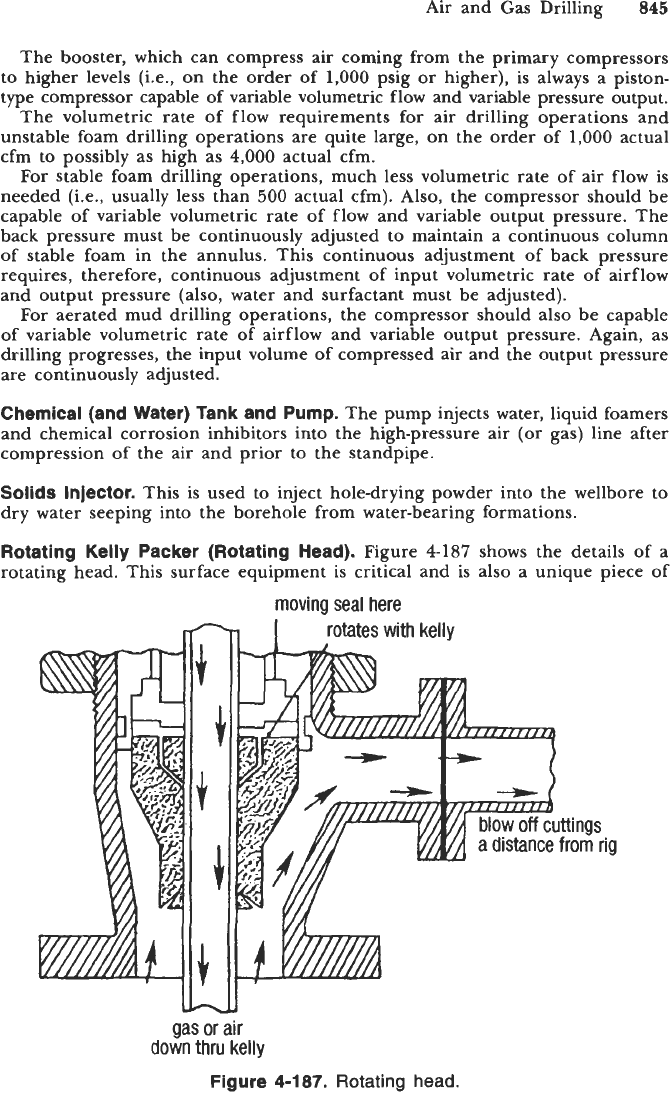
Air and Gas Drilling
845
The booster, which can compress
air
coming from the primary compressors
to higher levels (i.e., on the order of
1,000
psig
or
higher), is always a piston-
type compressor capable of variable volumetric flow and variable pressure output.
The volumetric rate of flow requirements for air drilling operations and
unstable foam drilling operations are quite large,
on
the order of
1,000
actual
cfm to possibly as high as
4,000
actual cfm.
For
stable foam drilling operations, much less volumetric rate of air flow is
needed (Le., usually less than
500
actual cfm). Also, the compressor should be
capable of variable volumetric rate of flow and variable output pressure. The
back pressure must be continuously adjusted
to
maintain a continuous column
of stable foam in the annulus. This continuous adjustment of back pressure
requires, therefore, continuous adjustment of input volumetric rate
of
airflow
and output pressure (also, water and surfactant must be adjusted).
For
aerated mud drilling operations, the compressor should also be capable
of variable volumetric rate of airflow and variable output pressure. Again, as
drilling progresses, the input volume of compressed air and the output pressure
are continuously adjusted.
Chemical (and Water) Tank and Pump.
The pump injects water, liquid foamers
and chemical corrosion inhibitors into the high-pressure air (or gas) line after
compression of the air and prior to the standpipe.
Solids Injector.
This is used to inject hole-drying powder into the wellbore to
dry water seeping into the borehole from water-bearing formations.
Rotating Kelly Packer (Rotatlng Head).
Figure
4-187
shows the details of a
rotating head, This surface equipment is critical and is also a unique piece of
moving
seal
here
gas
or
air
down
thru
kelly
Figure
4-1
87.
Rotating head.

846
Drilling and Well Completions
equipment to air drilling operations. The rotating head packs off the annulus
return flow from the rig floor (i.e., seals against the rotating kelly) and diverts
the upward flowing air (or gas) and cuttings to the blooey line. Little pressure
(a few psig) exists in the annulus flow at the rotating head.
Kelly.
Because of its greater seal effectiveness within the rotating head, a hexa-
gonal rather than
a
square
kelly should be used in air (or gas) drilling operations.
Scrubber.
This removes excess water from the injected
air
(or gas) stream to
ensure that
a
minimum of moisture is circulated (if dry air for drilling is
required)
and
to protect the booster.
Sample Catchers.
A
small-diameter pipe (about
2
in.) is fixed
to
the bottom
of the blooey line to facilitate the catching and retaining of downhole cutting
samples for geologic examination.
De-Duster.
This provides a spray of water at the end of the blooey line to wet
down the dust particles exiting the blooey line.
Gas Sniffer.
This instrument can be hooked into the blooey line to detect very
small amounts
of
natural gas entering the return flow from the annulus.
Pilot
Light.
This is
a
small continuously operated flame at the end of
the
blooey
line, and it will ignite any natural gas encountered while drilling.
Burn
Pit. This pit
is
at the end of the blooey line and provides a location for
the cutting returns, foam and for natural gas or oil products from the subsurface
to be ignited by the pilot light and burned off. The burn pit should be located
away from the standard mud drilling reserve pit.
Meter for Measurlng Air (or Gas) Volume.
A
standard orifice meter is generally
used to measure air
(or
gas) injection volume rates.
Downhole Equipment
Special pieces of downhole equipment and special concerns must be con-
sidered during downhole air
(or
gas) drilling operations.
Float-valve Subs.
These subs are at the bottom and near the top of the drill
string. The bottom float-valve sub prevents the backflow of cuttings into the
drill string during connections or other air (or gas) flow shutdowns that would
otherwise plug the bit. The bottom float-valve sub also aids in preventing
extensive damage to the drill string in the event of a downhole fire. The top
(or upper) float-valve subs aid in retaining high pressure air (or gas) within a
long drill string while making connections
or
other shutdowns.
Bottomhole Assemblies.
In general, the drill pipe, drill collars and, in
particular, bottomhole assemblies for
air
(or gas) drilling operations
are
the same
as those in mud drilling. However, because the penetration rate is much greater
in air (or gas) drilling operations due
to
the lack of confining pressure
on
the
bit cutting surface, care must be taken
to
control unwanted deviation of the
borehole. Thus, for air (or gas) drilled boreholes, a packed-hole
or
stiff bottom-
hole assembly is recommended.
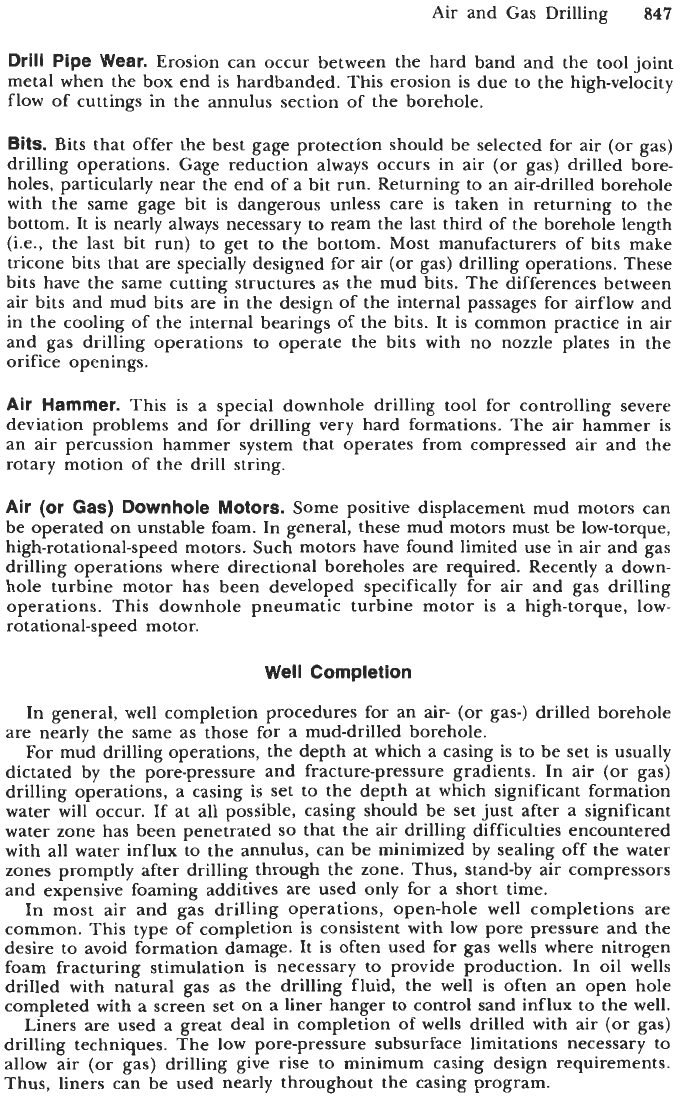
Air and Gas Drilling
847
Drill Pipe Wear.
Erosion can occur between the hard band and the tool joint
metal when the box end is hardbanded. This erosion is due to the high-velocity
flow of cuttings in the annulus section
of
the borehole.
Bits.
Bits that offer the best gage protection should be selected for air (or gas)
drilling operations. Gage reduction always occurs in air (or gas) drilled bore-
holes, particularly near the end
of
a bit run. Returning to an air-drilled borehole
with the same gage bit
is
dangerous unless care is taken in returning to the
bottom. It is nearly always necessary to ream the last third of the borehole length
(Le., the last bit run) to get to the bottom. Most manufacturers of bits make
tricone bits that are specially designed for air (or gas) drilling operations. These
bits have the same cutting structures as the mud bits. The differences between
air bits and mud bits are in the design of the internal passages for airflow and
in the cooling
of
the internal bearings
of
the bits. It is common practice in air
and gas drilling operations to operate the bits with no nozzle plates in the
orifice openings.
Air Hammer.
This is a special downhole drilling tool for controlling severe
deviation problems and for drilling very hard formations. The air hammer is
an air percussion hammer system that operates from compressed air and the
rotary motion of the drill string.
Air
(or Gas) Downhole Motors.
Some positive displacement mud motors can
be operated on unstable foam. In general, these mud motors must be low-torque,
high-rotational-speed motors. Such motors have found limited use in air and gas
drilling operations where directional boreholes are required. Recently a down-
hole turbine motor has been developed specifically for air and gas drilling
operations. This downhole pneumatic turbine motor is a high-torque, low-
rotational-speed motor.
Well Completion
In general, well completion procedures for an air- (or gas-) drilled borehole
are nearly the same as those for
a
mud-drilled borehole.
For mud drilling operations, the depth at which a casing is to be set is usually
dictated by the pore-pressure and fracture-pressure gradients. In air (or gas)
drilling operations, a casing is set to the depth at which significant formation
water will occur. If at all possible, casing should be set just after a significant
water zone has been penetrated
so
that the air drilling difficulties encountered
with all water influx to the annulus, can be minimized
by
sealing off the water
zones promptly after drilling through the zone. Thus, stand-by air compressors
and expensive foaming additives are used only for a short time.
In most air and gas drilling operations, open-hole well completions are
common. This type
of
completion is consistent with low pore pressure and the
desire to avoid formation damage. It is often used for gas wells where nitrogen
foam fracturing stimulation is necessary to provide production. In oil wells
drilled with natural gas
as
the drilling fluid, the well is often
an
open hole
completed with a screen set on a liner hanger to control sand influx to the well.
Liners are used a great deal in completion of wells drilled with air (or gas)
drilling techniques. The low pore-pressure subsurface limitations necessary to
allow air (or gas) drilling give rise to minimum casing design requirements.
Thus, liners can be used nearly throughout the casing program.

848
Drilling and Well Completions
In many air and gas drilling operations when casing or a liner is set, the
casing or liner is lowered into the dry borehole and once the bottom has been
reached, the casing
or
liner is landed (with little or no compression on the lower
part of the casing or liner string). After landing the casing or liner, the borehole
is then filled with water (with appropriate additives), and cement is pumped to
the annulus around the casing or liner and the water in the borehole is displaced
to the surface. The cement is followed by water and the cement is allowed to
set. After the cement has set, there is water inside the casing
(or
liner) that
must be removed before air (or gas) drilling can proceed.
The following procedure is recommended for unloading and drying a borehole
prior to drilling ahead on air
[73]:
1. Run the drill string complete with desired bottomhole assembly and bit
to bottom.
2. Start the mud pump, running as slowly as possible, to pump fluid at a
rate of 1.5 to 2.0 bbl/min. This reduces fluid friction resistance pressures
to a minimum and pumps at minimum standpipe pressure for circulation.
The standpipe pressure (for 1.5 to
2.0
bbl/min) can be found from
standard fluid hydraulic calculations.
3.
Bring one compressor and booster on line to aerate the fluid pumped
downhole; approximately
100
to 150 scfm/bbl of fluid should be sufficient
for aeration.
If the air volume used is too high, standpipe pressure will exceed the
pressure rating of the compressor (and/or booster). Therefore, the
compressor must be slowed down until air is mixed with the fluid going
downhole.
The mist pump should inject water at a rate of about 12 bbl/hr; the
foam injection pump should inject about
3
gal/hr of surfactant; this binds
fluid and air together for more efficient aeration.
As
the fluid column in the annulus is aerated, standpipe pressure will
drop. Additional compressors (i.e., increased air volume) can then be
added to further lighten the fluid column and unload the hole.
Compared to the slug method of unloading the hole, the aeration
method is more efficient. The slug method consists of alternately pump-
ing first air (injected up to an arbitrary maximum pressure) and then
water (to reduce the pressure to an arbitrary minimum); this procedure
is repeated until air can be injected continuously. The aeration method
takes less time, causes no damage to pit walls from surges (as can happen
with alternate slugs of air and water) and can generally be done at lower
operating pressures.
5.
After the hole has been unloaded, keep mist and foam injection pumps
in operation to clean the hole
of
sloughing formations, providing a mist
of
1.5
barrels of water per hour per inch of hole diameter and 0.5 to
4
gal of surfactant per hour, respectively.
6.
At this point, begin air
or
mist drilling. Drill
20
to 100 ft to allow any
sloughing hole to be cleaned up.
7.
Once the hole has been stabilized (Le., after sloughing), stop drilling and
blow the hole with air mist to eliminate cuttings. Continue this procedure
for 15 to 20 min or until the air mist is clean (i.e., shows a fine spray
and white color).
8.
Replace the kelly and set the bit on bottom. Since the hole is now full
of air, surfactant and water will run to the bottom. Unless mixed with
air and pumped up the annulus (which cannot be done if the drill bit is
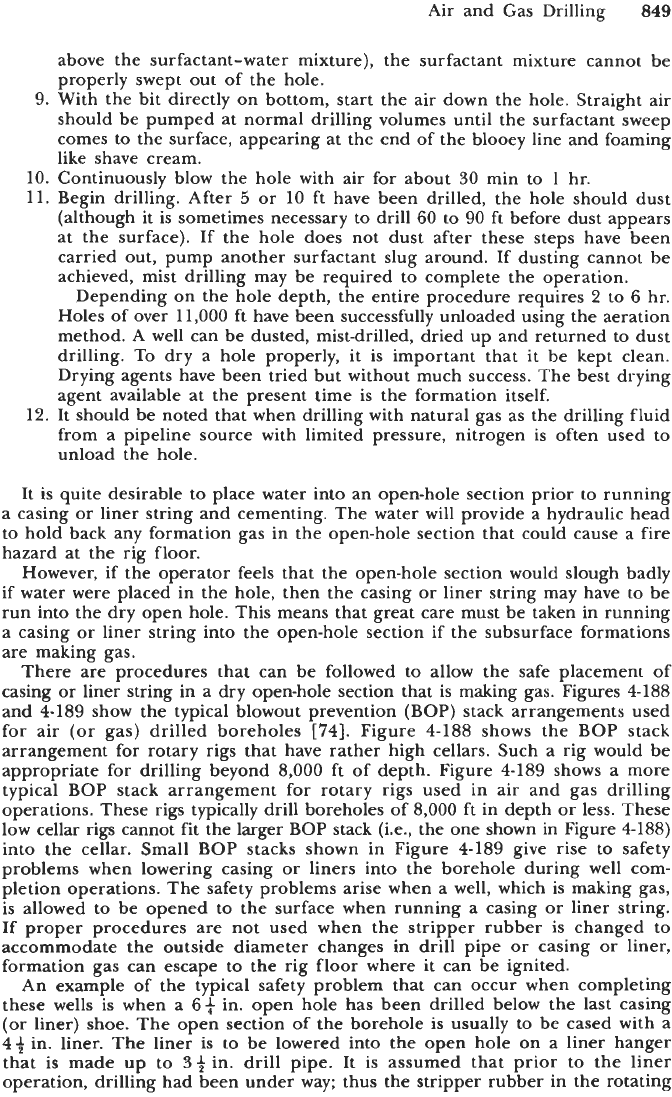
Air and Gas Drilling
849
above the surfactant-water mixture), the surfactant mixture cannot be
properly swept out of the hole.
9.
With the bit directly on bottom, start the air down the hole. Straight air
should be pumped at normal drilling volumes until the surfactant sweep
comes to the surface, appearing at the end of the blooey line and foaming
like shave cream.
10.
Continuously blow the hole with air for about
30
min to
1
hr.
11.
Begin drilling. After
5
or
10
ft have been drilled, the hole should dust
(although it is sometimes necessary to drill
60
to
90
ft before dust appears
at the surface). If the hole does not dust after these steps have been
carried out, pump another surfactant slug around. If dusting cannot be
achieved, mist drilling may be required to complete the operation.
Depending on the hole depth, the entire procedure requires
2
to
6
hr.
Holes of over
11,000
ft have been successfully unloaded using the aeration
method.
A
well can be dusted, mist-drilled, dried up and returned to dust
drilling. To dry a hole properly, it is important that it be kept clean.
Drying agents have been tried but without much success. The best drying
agent available at the present time is the formation itself.
12.
It should be noted that when drilling with natural gas as the drilling fluid
from a pipeline source with limited pressure, nitrogen
is
often used to
unload the hole.
It is quite desirable to place water into an open-hole section prior to running
a casing or liner string and cementing. The water will provide a hydraulic head
to hold back any formation gas in the open-hole section that could cause a fire
hazard at the rig floor.
However, if the operator feels that the open-hole section would slough badly
if water were placed in the hole, then the casing
or
liner string may have to be
run into the dry open hole. This means that great care must be taken in running
a casing or liner string into the open-hole section if the subsurface formations
are making gas.
There are procedures that can be followed to allow the safe placement of
casing or liner string in a dry open-hole section that is making gas. Figures
4-188
and
4-189
show the typical blowout prevention (BOP) stack arrangements used
for air (or gas) drilled boreholes
[74].
Figure
4-188
shows the BOP stack
arrangement for rotary rigs that have rather high cellars. Such a rig would be
appropriate for drilling beyond
8,000
ft of depth. Figure
4-189
shows a more
typical
BOP
stack arrangement for rotary rigs used in air and gas drilling
operations. These rigs typically drill boreholes of
8,000
ft in depth or less. These
low cellar rigs cannot fit the larger BOP stack (i.e., the one shown in Figure
4-188)
into the cellar. Small
BOP
stacks shown in Figure
4-189
give rise to safety
problems when lowering casing or liners into the borehole during well com-
pletion operations. The safety problems arise when a well, which is making gas,
is allowed to be opened to the surface when running a casing or liner string.
If
proper procedures are not used when the stripper rubber is changed to
accommodate the outside diameter changes in drill pipe or casing or liner,
formation gas can escape to the rig floor where it can be ignited.
An example of the typical safety problem that can occur when completing
these wells is when a
6+
in. open hole has been drilled below the last casing
(or
liner) shoe. The open section
of
the borehole is usually to be cased with a
4+
in. liner. The liner is to be lowered into the open hole on a liner hanger
that is made up to
34
in, drill pipe. It is assumed that prior to the liner
operation, drilling had been under way; thus the stripper rubber in the rotating
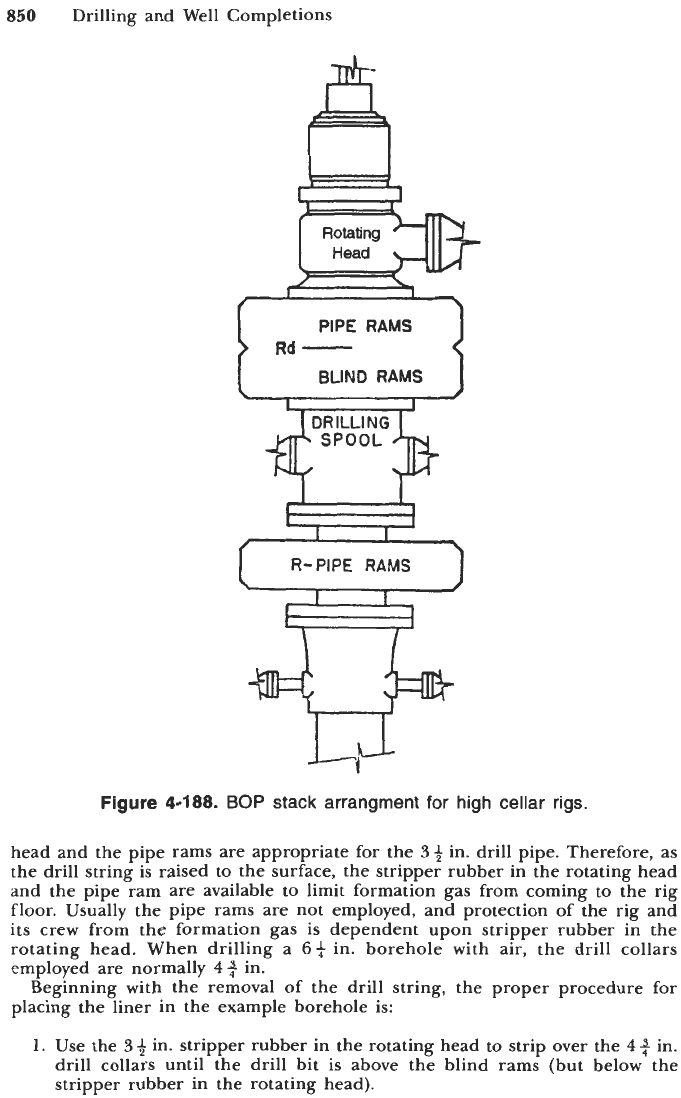
850
Drilling and Well Completions
A
Figure
4-188.
BOP
stack arrangrnent
for
high cellar rigs.
head and the pipe rams are appropriate for the
3
+
in. drill pipe. Therefore, as
the drill string is raised to the surface, the stripper rubber in the rotating head
and the pipe ram are available to limit formation gas from coming
to
the rig
floor. Usually the pipe rams are not employed, and protection of the rig and
its crew from the formation gas is dependent upon stripper rubber in the
rotating head. When drilling a
6$
in. borehole with air, the drill collars
employed are normally
4Q
in.
Beginning with the removal of the drill string, the proper procedure for
placing the liner in the example borehole is:
1.
Use the
3
+
in. stripper rubber in the rotating head to strip over the
4
+
in.
drill collars until the drill bit is above the blind rams (but below the
stripper rubber in the rotating head).
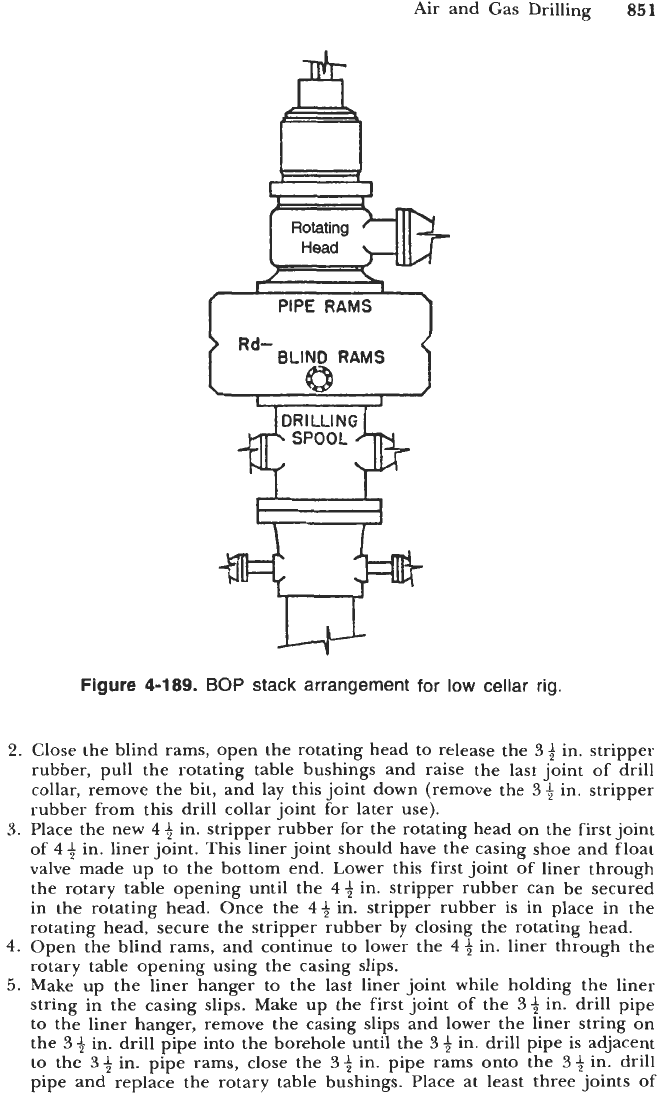
Air and Gas Drilling
851
Rotating
[-a
1
\
PIPE
RAMS
I
Figure
4-189.
BOP
stack arrangement for
low
cellar
rig.
2.
Close the blind rams, open the rotating head to release the
3
+
in. stripper
rubber, pull the rotating table bushings and raise the last joint of drill
collar, remove the bit, and lay this joint down (remove the
3
in. stripper
rubber from this drill collar joint for later use).
3.
Place the new
4
+
in. stripper rubber for the rotating head on the first joint
of
4
+
in. liner joint. This liner joint should have the casing shoe and float
valve made up to the bottom end. Lower this first joint of liner through
the rotary table opening until the
4+
in. stripper rubber can be secured
in the rotating head. Once the
44
in. stripper rubber is in place in the
rotating head, secure the stripper rubber by closing the rotating head.
4.
Open the blind rams, and continue to lower the
4+
in. liner through the
rotary table opening using the casing slips.
5.
Make up the liner hanger to the last liner joint while holding the liner
string in the casing slips. Make up the first joint of the
3
4
in. drill pipe
to the liner hanger, remove the casing slips and lower the liner string on
the
3
in. drill pipe into the borehole until the
3
+
in. drill pipe is adjacent
to the
3+
in. pipe rams, close the
3
+
in. pipe rams onto the
3
+
in. drill
pipe and replace the rotary table bushings. Place at least three joints
of
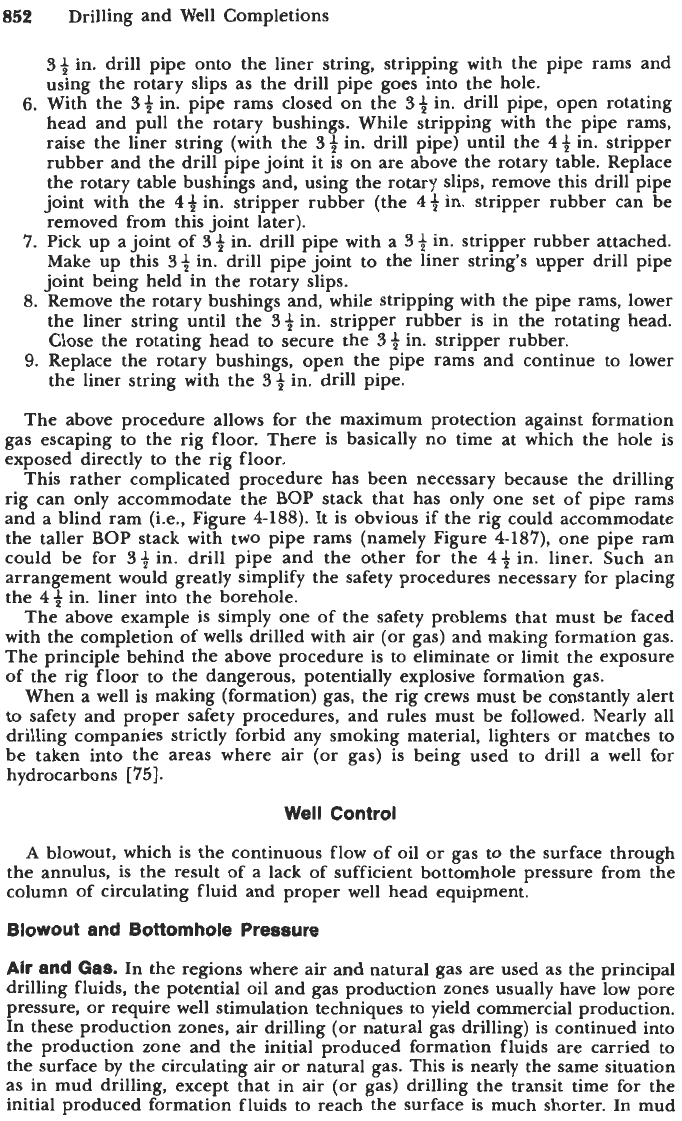
854
Drilling and Well Completions
33
in. drill pipe onto the liner string, stripping with the pipe rams and
using the rotary slips as the drill pipe goes into the hole.
6.
With the
33
in. pipe rams closed on the
33
in. drill pipe, open rotating
head and pull the rotary bushings. While stripping with the pipe rams,
raise
the
liner string (with the
3
+
in. drill pipe) until the 4
+
in. stripper
rubber and the drill pipe joint it
is
on
are
above the rotary table. Replace
the rotary table bushings and, using the rotary slips, remove this drill pipe
joint with the 43 in. stripper rubber (the 43 in. stripper rubber can be
removed from this joint later).
7. Pick up a joint of
34
in. drill pipe with a
34
in. stripper rubber attached.
Make up this
34
in. drill pipe joint to the liner string’s upper drill pipe
joint being held in the rotary slips.
8.
Remove the rotary bushings and, while stripping with the pipe rams, lower
the liner string until the
33
in. stripper rubber is in the rotating head.
Close the rotating head to secure the
33
in. stripper rubber.
9.
Replace the rotary bushings, open the pipe rams and continue to lower
the liner string with the
33
in. drill pipe.
The above procedure allows for the maximum protection against formation
gas escaping to the rig floor. There is basically no time at which the hole is
exposed directly to the rig floor.
This rather complicated procedure has been necessary because the drilling
rig can only accommodate the BOP stack that has only one set of pipe rams
and a blind ram (i.e., Figure
4-188).
It is obvious if the rig could accommodate
the taller BOP stack with two pipe rams (namely Figure 4-187), one pipe ram
could be for
33
in. drill pipe and the other for the
44
in. liner. Such an
arrangement would greatly simplify the safety procedures necessary for placing
the
44
in. liner into the borehole.
The above example is simply one of the safety problems that must be faced
with the completion of wells drilled with
air
(or
gas) and making formation gas.
The principle behind the above procedure is to eliminate or limit the exposure
of the rig floor to the dangerous, potentially explosive formation gas.
When
a
well is making (formation) gas, the rig crews must be constantly alert
to safety and proper safety procedures, and rules must be followed. Nearly all
drilling companies strictly forbid any smoking material, lighters
or
matches
to
be taken into the areas where air
(or
gas) is being used
to
drill a well for
hydrocarbons [75].
Well
Control
A
blowout, which is the continuous flow of oil
or
gas to the surface through
the annulus, is the result of a lack of sufficient bottomhole pressure from the
column of circulating fluid and proper well head equipment.
Blowout
and
Bottomhole
Pressure
Air
and
Gas.
In the regions where
air
and
natural gas
are
used as the principal
drilling fluids, the potential oil and gas production zones usually have low pore
pressure,
or
require well stimulation techniques
to
yield commercial production.
In these production zones, air drilling
(or
natural gas drilling) is continued into
the production zone and the initial produced formation fluids are carried to
the surface by the circulating air
or
natural gas. This is nearly the same situation
as in mud drilling, except that in air
(or
gas) drilling the transit time for the
initial produced formation fluids to reach the surface is much shorter. In mud
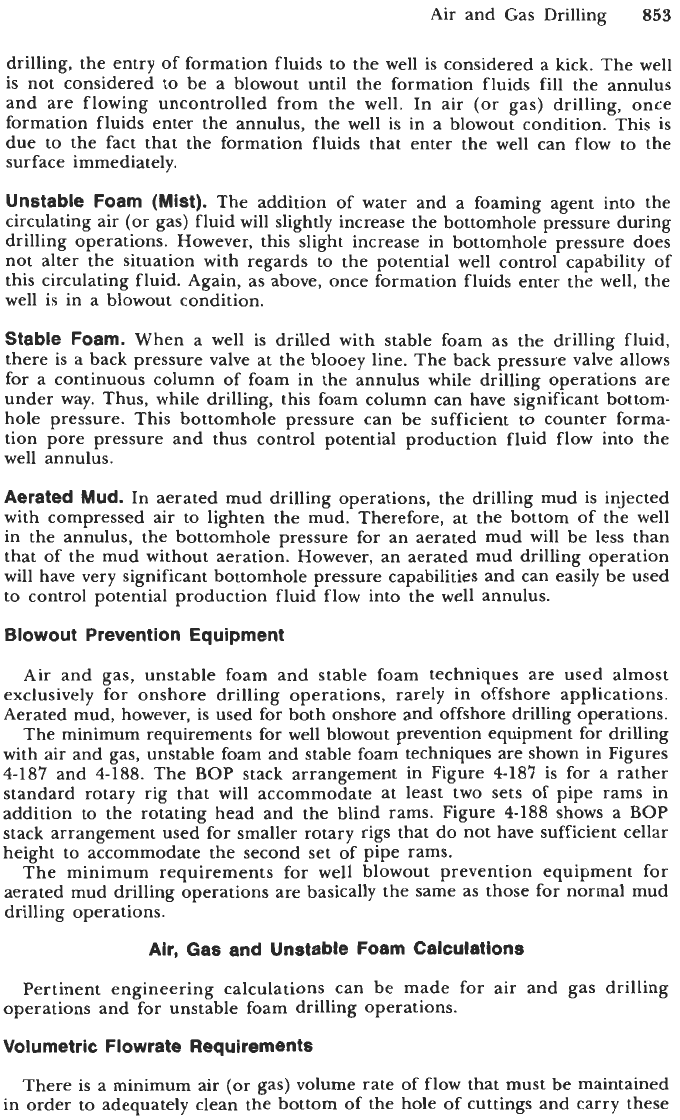
Air and Gas Drilling
853
drilling, the entry of formation fluids to the well is considered a kick. The well
is not considered to be a blowout until the formation fluids fill the annulus
and are flowing uncontrolled from the well. In air (or gas) drilling, once
formation fluids enter the annulus, the well is in a blowout condition. This is
due to the fact that the formation fluids that enter the well can flow to the
surface immediately.
Unstable Foam (Mist).
The addition of water and a foaming agent into the
circulating air (or gas) fluid will slightly increase the bottomhole pressure during
drilling operations. However, this slight increase in bottomhole pressure does
not alter the situation with regards to the potential well control capability
of
this circulating fluid. Again, as above, once formation fluids enter the well, the
well
is
in a blowout condition.
Stable Foam.
When a well is drilled with stable foam as the drilling fluid,
there is a back pressure valve at the blooey line. The back pressure valve allows
for a continuous column of foam in the annulus while drilling operations are
under way. Thus, while drilling, this foam column can have significant bottom-
hole pressure. This bottomhole pressure can be sufficient to counter forma-
tion pore pressure and thus control potential production fluid flow into the
well annulus.
Aerated Mud.
In aerated mud drilling operations, the drilling mud is injected
with compressed air to lighten the mud. Therefore, at the bottom of the well
in the annulus, the bottomhole pressure for an aerated mud will be less than
that of the mud without aeration. However, an aerated mud drilling operation
will have very significant bottomhole pressure capabilities and can easily be used
to control potential production fluid flow into the well annulus.
Blowout Prevention Equipment
Air and gas, unstable foam and stable foam techniques are used almost
exclusively for onshore drilling operations, rarely in offshore applications.
Aerated mud, however, is used for both onshore and offshore drilling operations.
The minimum requirements for well blowout prevention equipment for drilling
with air and gas, unstable foam and stable foam techniques are shown in Figures
4-187
and
4-188.
The
BOP
stack arrangement in Figure
4-187
is for a rather
standard rotary rig that will accommodate at least two sets of pipe rams in
addition to the rotating head and the blind rams. Figure
4-188
shows a
BOP
stack arrangement used for smaller rotary rigs that
do
not have sufficient cellar
height to accommodate the second set of pipe rams.
The minimum requirements for well blowout prevention equipment for
aerated mud drilling operations are basically the same as those for normal mud
drilling operations.
Air, Gas and Unstable Foam Calculations
Pertinent engineering calculations can be made for air and gas drilling
operations and for unstable foam drilling operations.
Volumetric Flowrate Requirements
There is a minimum air (or gas) volume rate of flow that must be maintained
in order to adequately clean the bottom of the hole of cuttings and carry these
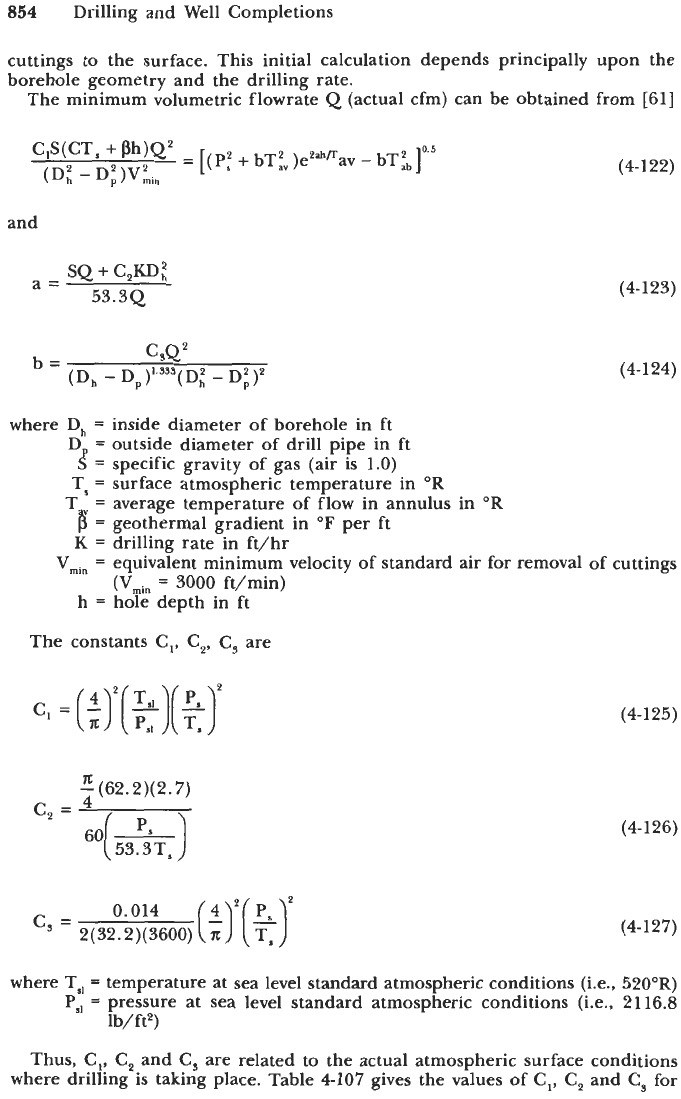
854
Drilling and Well Completions
cuttings to the surface. This initial calculation depends principally upon the
borehole geometry and the drilling rate.
The minimum volumetric flowrate
Q
(actual cfm) can be obtained from
[61]
and
SQ
+
C,KD:
53.352
a=
(4- 122)
(4-123)
(4-124)
where D,
=
inside diameter of borehole in ft
A'
=
specific gravity of gas (air is
1.0)
D
=
outside diameter of drill pipe in ft
TS
=
surface atmospheric temperature in
OR
Tv
=
average temperature of flow in annulus in
OR
=
geothermal gradient in
OF
per ft
K
=
drilling rate in ft/hr
(Vmin
=
3000 ft/min)
Vmin
=
equivalent minimum velocity of standard air for removal of cuttings
h
=
hole depth in ft
The constants
C,, C,,
C, are
n
-
(62.2)( 2.7)
4
c,
=
c,
=
(4-125)
(4-126)
(4-
127)
where T,
=
temperature at sea level standard atmospheric conditions (i.e.,
520OR)
P,
=
pressure at sea level standard atmospheric conditions (i.e., 2116.8
lb/ft2)
Thus, C,,
C,
and
C,
are related to the actual atmospheric surface conditions
where drilling is taking place. Table
4107
gives the values of C,, C, and C, for
